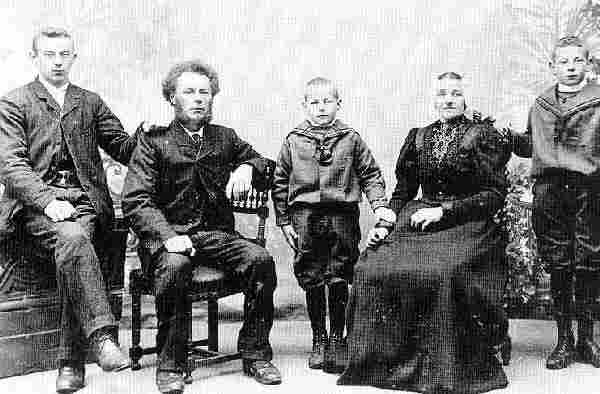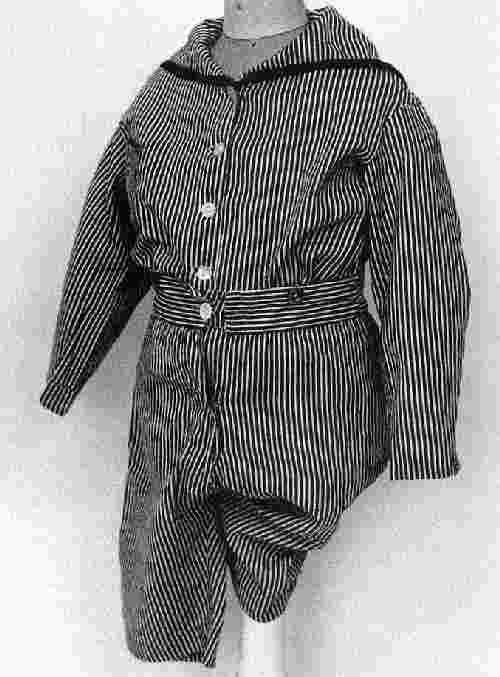
Dutch Sailor Suits
The sailor suit was one of the most important Dutch boy's style for perhaps three generations. The authors believe that the sailor suit was an especially popular style in the Netherlands, perhaps in part due to the country's maritime tradition. We still have limited information on Dutch sailor suits, but they appear to have been widely worn by the 1880s. Sailor suits were normally worn with kneepants or knickers. After World War I (1914-18) short pants sailor suits become more important, but were worn by younger boys. HBC has not noted destinctively styled Dutch sailor suits, but rather boys wore common styles developed in other countries. Probably English and German styles were the most important influences.
Chronology
The sailor suit was one of the most important Dutch boy's style for perhaps three generations. The Netherland's rich maritime tradition was no doubt a factor here. The use of the sailor suit as a boy's garment, however, was a tradition imported from England as was the case in other European countries. We still have limited information on Dutch sailor suits. We do not know when the sailor suit was first worn by Dutch boys or when it first became a popular style. The sailor suit does appear to have been widely worn by the 1880s. Sailor suits were normally worn with kneepants or knickers. Many Dutch boys webt to school dressed in sailir suits during the early 20th century. After World War I (1914-18) short pants sailor suits become more important, but were worn by younger boys. Dutch boys wore sailor suits in the inter-war period after World War I, but the style becomes less common after World War II (1939-45). WE note, however, that the fashion magazinde Libelle still showed sailor suits for younger boys in 1950. We do not have size details, but they look to be for younger primary school boys.
Popularity
The authors believe that the sailor suit was an especially popular style in the Netherlands, perhaps in part due to the country's maritime tradition.
Styles
HBC has not noted destinctively styled Dutch sailor suits, but rather boys wore common styles developed in other countries. Probably English and German styles were the most important influences.
|
Garments
Dutch boys wore the same standard sailor suit garments as worn by boys in other European countries. Garments have included caps and hats, middy blouses, reefer jackerts, various types of pants, and long stovkings and kneesocks. Some items like the middy blose changed lottle over time. The hats, pants, and stockings on the other hand changed considerably.
Types
HBC has noted several different styles suchbas middy suits, reefer suits, and a variety of playsuits.
Seasonnality
Boys normally has winter and summer sailor suits. The winter suits were often made in heavy wool fabrics and wither dark blue or black. The summer suits were lighter weight garments made in white or light or stripped colors.
Age
HBC does not yet have details on the ages at which Dutch boys wore sailor suits. This was in part affected by the years boys wore their sailor suits.
Family Fashion
Dutch mothers would in some occassions dress all the boys in the family, or at least the ones of appropriate ages in identical sailor suits. This custom appears to have been most common in the late 19th century when boys of a fairly wide range of ages wore sailor suits.
Companies
HBC has only limited informatin as to the Dutch companies producing sailor suits. One of the most important producers, however, was Bleyle--a German company. Wilhelm Bleyle had a factory producing mostly knitwear in Stuttgart, Germany. We do not know when the form was founded. Most German and Dutch boys ages 8-12 for several generations owned a Bleyle sailor suit. Bleyle products were very popular in Holland, so I assume that the sailor suits Dutch boys wore came from Bleyle in Germany. This is one of many indicators of fashion connections between the Dutch and Germans. We know nothing about the company at this time, except that they provide high quality clothing at somewhat expensive prices. They are still operating, but the only company website we could find was still "under construction". We note that U.S. retailers in 2002 are marketing Bleyle women's clothes.
Navigate the Boys' Historical Clothing Web Site: Navigate the Boys' Historical Clothing Dutch pages: Navigate the Boys' Historical Clothing national pages:
HBC
[Introduction]
[Activities]
[Biographies]
[Chronology]
[Clothing styles]
[Countries]
[Bibliographies]
[Contributions]
[FAQs]
[Glossaries]
[Images]
[Links]
[Registration]
[Tools]
[Boys' Clothing Home]
[Return to the Main Dutch boys' garments page]
[Return to the Main Dutch boy's clothing page]
[Return to the Main national sailor suit page]
[Maiken Island]
[Dutch choirs]
[Dutch royalty]
[Dutch scouts]
[Dutch school uniform]
[Dutch boys bangs]
[Return to the Main countries page]
[Australia]
[Belgium]
[England]
[France]
[Germany]
[Ireland]
[Italy]
[Japan]
[Korea]
[Mexico]
[Netherlands]
[Scotland]
[United States]
Created: March 26, 2001
Last updated: 2:26 AM 5/19/2014



